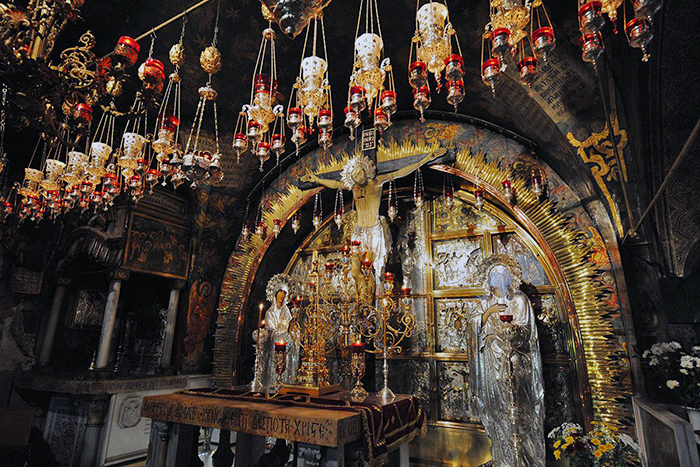
The 12th century manuscript that serves as the basis for this article was discovered in 1884 by the Italian archaeologist Rammurini in Arezzo (Italy). Later it became known as The Pilgrimage to Holy Places and attributed to Hetaireia (Sylvia of Aquitaine), a noble woman “from distant parts of the world”, presumably from Gaul. Having spent about three years in the Holy Land, this woman made multiple pilgrimages. She describes temples and religious services in the late 4th century Church of Jerusalem providing data of tremendous historical importance. The article gives this devout Christian woman’s account of a Sunday liturgy in the Holy City.
Matins in the Anastasis
Weekday matins was celebrated long before sunrise and consisted of psalms, antiphons and hymns sung responsorially by the clergymen with the congregation responding to each verse. The entire service took part in the Resurrection Church, known more commonly as the Church of the Holy Sepulchre. The bishop would join the clergy closer to the break of dawn adding solemnity to the celebration. There were some differences in Sunday matins. It included a reading of the Gospel and began not in the part of the church known as Anastasis but in the adjacent basilica. With the bishop’s arrival, the Resurrection Church’s doors opened allowing the congregation into the lavishly lit temple. Three psalms were sung responsorially, one by the presbyter, one by deacon and one by another clergyman. Each psalm was followed by a separate prayer. The third prayer was combined with a universal memorial. The church then became filled with fragrance from the incensories brought in after the memorial announcing the upcoming Sunday Gospel reading. The bishop entered the altar divided from the church by a parclose. He would then take the Gospel and read the Sunday pericope standing in the parclose doors. Western pilgrimess notes exceptionally high numbers of people attending Sunday matins comparing them to Easter service. She also points out the devout eagerness of the faithful attending to God’s Word with tears in their eyes.
Litia to the Holy Cross
The Gospel reading was followed by artoklasia (litia) to the Holy Cross served in a separate church built in the place where the True Holy Cross of Our Lord Jesus Christ had been found and kept. The church was separated from the basilica by a vast courtyard. After celebrating the litia with the troparions, reading a psalm and proclaiming a prayer in the Church of the Cross, the bishop blessed the congregation and having pronounced the dismissal, left temporarily. However, the service did not end with the departure of the bishop. The monks, the clergy and the most zealous of the faithful returned to the Church of the Resurrection, where they continued to sing psalms and antiphons, complementing them with prayers (Pilgrimage, 24). It must be said that in ancient times, both in the West and in the East, psalms during divine services were always accompanied by appropriate psalm-inspired prayers that were in fact their paraphrase (e. g. the 50th psalm and the 10th “Lighting of the Lamps” prayer of Matins in the Service Book).
Liturgy in the Martyrium
“At dawn in the Martyrium (the church that was built on Calvary, the place of the Lord’s torment and crucifixion, hence the name Martyrium), everything is done according to the generally-observed Sunday custom,” Sylvia continues her description. The liturgy was not finished before 10-11 am due to the Jerusalemite tradition of allowing any presbyter to say his word of teaching before the bishop himself preached. After the end of the liturgy, the bishop, together with the monks, made a procession back to the Church of the Resurrection, where, to the sound of church chants, only the faithful entered, without the catechumens. The bishop again entered the cave of the Holy Sepulcher, separated from the temple by a parclose and serving as the altar. Further followed an additional thanksgiving to God (aguntut gratiae), the “Bowing of the Heads” prayer, a bishop’s blessing from the altar and the dismissal. The entire service ended towards noon. The hours were not read on Sunday which, according to prof. Mikhail N. Skaballanovich, was why the additional thanksgiving part was added (Explanatory Typicon).
So, a noble Christian lady from faraway Gaul was presented with a picture of a very vibrant and dynamic divine service that began long before dawn, continued throughout the morning and ended at noon. As it appears, the internal structure of the divine service did not differ much from the rituals, customary for the pilgrimess from the West where, just like in the Eastern rites, it was only beginning to develop into harmonious systems. At the same time we can see the dynamics that have always distinguished Eastern divine services. Frequent litias, transitions from one church to another, visiting memorable evangelical places with processions are some of their distinctive features that left a mark on the Orthodox liturgy perceived by the ascetics as a constant ascent to the Throne of the Holy Trinity and an approach to the Father through the Blood of His Son.



